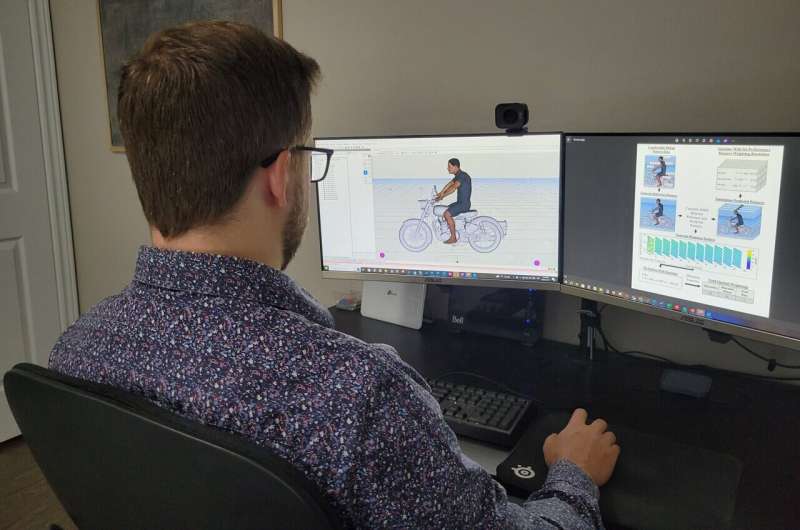This article has been reviewed according to Science X's editorial process and policies. Editors have highlighted the following attributes while ensuring the content's credibility:
fact-checked
peer-reviewed publication
trusted source
proofread
Digital human model aids design of motorcycles, based on riding posture

Motorcycles are designed to accommodate the average-sized rider, leaving taller and shorter riders vulnerable to discomfort.
A new study from the University of Waterloo used software that predicted realistic motorcycle riding behaviors, considering human factors and ergonomic trade-offs. It found that shorter and taller statures require joint adjustments to achieve their preferred riding posture. The study was published in Ergonomics.
Taller riders are required to flex their ankles, knees, hips and elbows more to interact with the motorcycle properly, and shorter riders have fewer options in possible joint angle configurations, allowing them to reach the seat, handlebars and foot pegs simultaneously.
The study was conducted using a digital human model (DHM)—a human representation in the form of an avatar of any weight, size or sex—in a virtual environment. The tool allows researchers to observe human interactions with components or products such as motorcycles.
"The use of DHMs in early two-wheeled motor vehicle design could help manufacturers improve safety, posture and comfort, in addition to saving costs," said Justin Davidson, Biomechanics Ph.D. candidate in Waterloo's Department of Kinesiology and Health Sciences and co-author of the study.
"If a vehicle manufacturer were to consider using DHMs earlier in their design, it could remove some of the earlier trial and error steps. We can change the design and improve it within the computer software before building anything, making it much cheaper in the long run."
Davidson added that the hope for the future is that companies will improve their designs to accommodate groups that fall outside the average size range, which could be done by studying avatars with various weights, heights and sexes within the DHM.
The ergonomics of motorcycle riding is a fairly understudied area despite motorcycle riding being an increasingly popular activity around the globe. Davidson suggested that as motorcycle sales increase, motorcycle design companies are trying to find technologies like DHMs to help them gain an edge.
"DHMs aren't as commonly used as they could be, and their potential for early design intervention could be useful not only when applied to motorcycles but for sitting in a car or even sitting in your office," Davidson said.
"Part of our goal in this research is to try to move the field forward in a way that people can use DHM tools more confidently so that we can start intervening and making things better for people earlier on, hopefully making people safer and more comfortable."
More information: Justin B. Davidson et al, Predicting preferred motorcycle riding postures to support human factors/ergonomic trade-off analyses within a multi-objective optimisation-based digital human model, Ergonomics (2024). DOI: 10.1080/00140139.2024.2329694



















